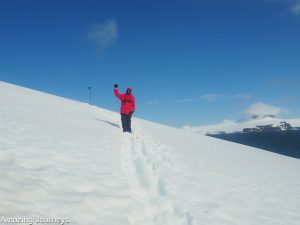
Cold Weather Photography
Sep 24, 2018
by Barry
I know that many of you, just like me, love to take pictures. What better way to remember your travels than coming home with amazing pictures to show off and hang up?

Photography in cold weather destinations like Iceland or Antarctica could present some “interesting” challenges. These revolve mainly around the weather and climate you will be enjoying. What comes to mind initially is the temperature that you will be experiencing.
Preparing for taking pictures in cold weather destinations can be divided into two categories:
1. Taking care of your camera and
2. Taking care of yourself.
First, most important, and most basic, is to take care of yourself. This means staying warm. I’m not going to talk a lot about this topic in general. I’ll leave this to your research. The one thing that I do want to mention is keeping your hands warm. As you are anticipating, the key here are gloves. What I do is bring a pair of regular warm gloves that I use here in Pittsburgh to stay warm and a special pair of “fingerless” gloves so that I have dexterity to operate my camera in the cold. There are several types of these “fingerless” gloves to use. My suggestion is to go to a sporting goods store (or online) and head to the hunting section. Hunters use these gloves all the time. Here is an example. Now, let’s talk photography! There are two issues that make photography in the cold “interesting”; power and water.

First let’s talk about power (batteries). The thing to remember is that, in cold temperatures, battery power goes down quickly. There is an easy solution to this; carry extra batteries. If you camera uses regular batteries, just pop a couple of extra sets in your coat close to your body (to keep them warm). When the set in your camera gets cold and stops working, just change them out for a “body warmed” set. (The cold set will come alive when warmed up again.) If your camera takes only proprietary rechargeable batteries, go to the camera store (or order) a second battery. Keep one warm while you shoot with the other; then just swap them out. Easy enough!
Now, let’s talk about water, two kinds: Ocean Spray and Condensation.
The easy one first: Ocean Spray. In places like Antarctica, you will be getting to shore by Zodiac rubber boats. There is the chance that you, and therefore your camera, may get wet. The solution is to transport it to shore in a waterproof bag. While a sealable baggy may be adequate, I prefer a “Dry Bag” to really protect my camera – here is the kind I have. The size you get depends on your camera size.
I’ve saved the “best” for last: Condensation. If you’ve been outside for a while in the cold air, then go inside the warm house; what’s the first thing that happens? Your glasses fog up. This occurs when your cold glasses hit the warm air. The same thing will happen to your camera. If you take your cold camera in to a warm room, the camera will instantly form condensation (water droplets) not only on the camera, but also inside the camera. Remember, water and electronics are not happy together, i.e. your camera’s guts will “fry”.

Preventing condensation on your camera is very important and not too difficult. Here’s the solution: While your camera is still cold, put it in a sealable plastic bag, and seal it tightly. Leave it in the sealed bag until, once back inside the ship, the camera slowly warms back up to room temperature. Problem solved! (Going from warm to cold should not be a problem, only cold to warm.) I actually throw a couple of those Silica Gel desiccant packs (the kind that comes with your new shoes to keep them dry) in my camera bag and the plastic bag for added protection.
Now, some of the above advice may be overkill, but you can never be too prepared.
My final words of wisdom:
1. Take plenty of memory cards
2. Take plenty of batteries and appropriately sized sealable baggies (see above)
3. If you’re going to get a new camera for the trip, get it now and learn how to use it now (don’t wait to open the box on the plane on the way to your destination!)
4. Practice using your camera and all of its settings. Being familiar with your camera will pay off in improved pictures.
Now you have one less thing to worry about as you prepare for your next cold weather amazing journey. Happy shooting!
View older entriesNo Comments
No comments yet.
RSS feed for comments on this post.
Sorry, the comment form is closed at this time.







